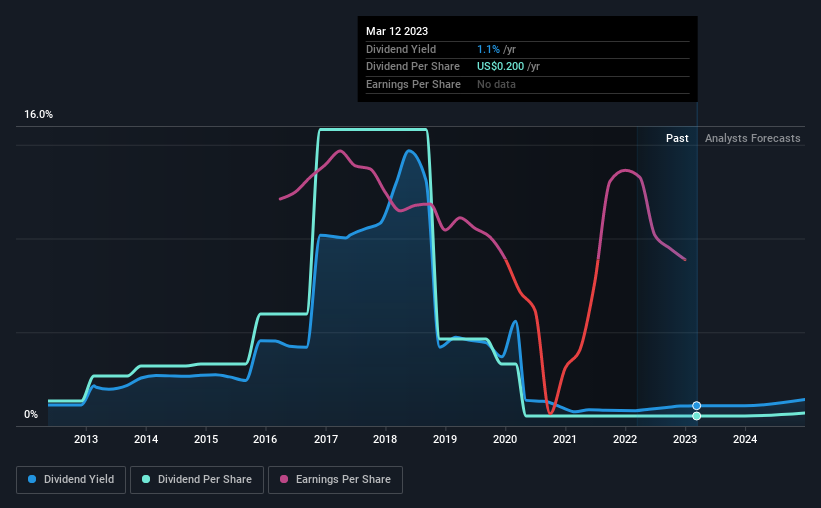The board of ProAssurance Corporation (NYSE:PRA) has announced that it will pay a dividend on the 13th of April, with investors receiving $0.05 per share. This means the annual payment will be 1.1% of the current stock price, which is lower than the industry average.
Check out our latest analysis for ProAssurance
ProAssurance Is Paying Out More Than It Is Earning
The dividend yield is a little bit low, but sustainability of the payments is also an important part of evaluating an income stock. Even in the absence of profits, ProAssurance is paying a dividend. It is also not generating any free cash flow, we definitely have concerns when it comes to the sustainability of the dividend.
EPS is forecast to rise very quickly over the next 12 months. Assuming the dividend continues along recent trends, we could see the payout ratio reach 519%, which is on the unsustainable side.

Dividend Volatility
While the company has been paying a dividend for a long time, it has cut the dividend at least once in the last 10 years. The annual payment during the last 10 years was $0.50 in 2013, and the most recent fiscal year payment was $0.20. The dividend has shrunk at around 8.8% a year during that period. A company that decreases its dividend over time generally isn't what we are looking for.
The Dividend Has Limited Growth Potential
Given that dividend payments have been shrinking like a glacier in a warming world, we need to check if there are some bright spots on the horizon. ProAssurance's earnings per share has shrunk at 14% a year over the past five years. Such rapid declines definitely have the potential to constrain dividend payments if the trend continues into the future. However, the next year is actually looking up, with earnings set to rise. We would just wait until it becomes a pattern before getting too excited.
ProAssurance's Dividend Doesn't Look Great
Overall, while some might be pleased that the dividend wasn't cut, we think this may help ProAssurance make more consistent payments in the future. The company's earnings aren't high enough to be making such big distributions, and it isn't backed up by strong growth or consistency either. Overall, the dividend is not reliable enough to make this a good income stock.
It's important to note that companies having a consistent dividend policy will generate greater investor confidence than those having an erratic one. However, there are other things to consider for investors when analysing stock performance. Given that earnings are not growing, the dividend does not look nearly so attractive. Very few businesses see earnings consistently shrink year after year in perpetuity though, and so it might be worth seeing what the 5 analysts we track are forecasting for the future. Looking for more high-yielding dividend ideas? Try our collection of strong dividend payers.
New: Manage All Your Stock Portfolios in One Place
We've created the ultimate portfolio companion for stock investors, and it's free.
• Connect an unlimited number of Portfolios and see your total in one currency
• Be alerted to new Warning Signs or Risks via email or mobile
• Track the Fair Value of your stocks
Have feedback on this article? Concerned about the content? Get in touch with us directly. Alternatively, email editorial-team (at) simplywallst.com.
This article by Simply Wall St is general in nature. We provide commentary based on historical data and analyst forecasts only using an unbiased methodology and our articles are not intended to be financial advice. It does not constitute a recommendation to buy or sell any stock, and does not take account of your objectives, or your financial situation. We aim to bring you long-term focused analysis driven by fundamental data. Note that our analysis may not factor in the latest price-sensitive company announcements or qualitative material. Simply Wall St has no position in any stocks mentioned.
About NYSE:PRA
ProAssurance
Through its subsidiaries, provides property and casualty insurance, and reinsurance products in the United States.
Moderate growth potential with mediocre balance sheet.
Similar Companies
Market Insights
Community Narratives




